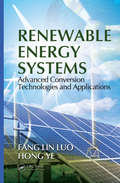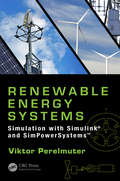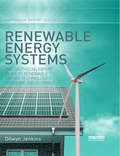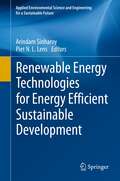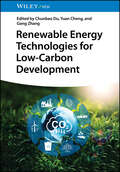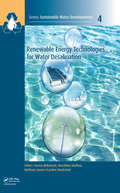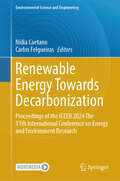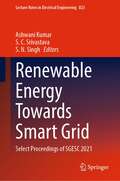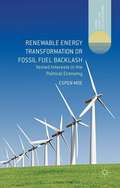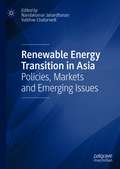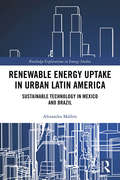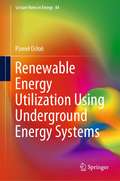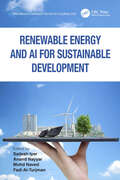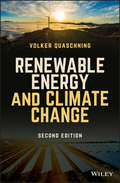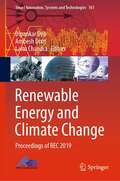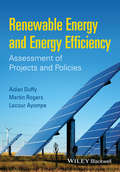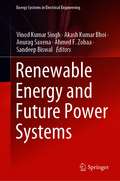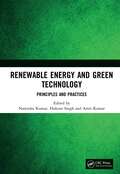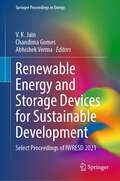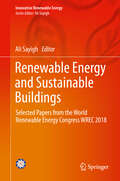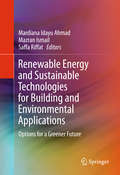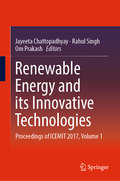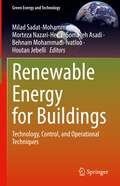- Table View
- List View
Renewable Energy Systems: Advanced Conversion Technologies and Applications (Industrial Electronics)
by Fang Lin Luo Ye HongEnergy conversion techniques are key in power electronics and even more so in renewable energy source systems, which require a large number of converters. Renewable Energy Systems: Advanced Conversion Technologies and Applications describes advanced conversion technologies and provides design examples of converters and inverters for renewable energy systems—including wind turbine and solar panel energy systems. Learn Cutting-Edge Techniques for Converters and Inverters Setting the scene, the book begins with a review of the basics of astronomy and Earth physics. It then systematically introduces more than 200 topologies of advanced converters originally developed by the authors, including 150 updated circuits on modern conversion technologies. It also discusses recently published topologies and thoroughly analyzes new converter circuits. Novel approaches include split-capacitor and split-inductor techniques that can be applied in super-lift and other converters. Resolve Historic Problems in Conversion Technologies Along with offering many cutting-edge techniques, the authors resolve some historic problems, such as the accurate determination of the conduction angle of single-phase rectifiers and power factor correction. They also describe a new series—laddered multilevel inverters—that uses few devices to produce more levels, overcoming the drawbacks of the pulse-width-modulation (PWM) inverter and providing great scope for industrial applications. Tap the Knowledge of Pioneers in the Field This book is written by pioneers in advanced conversion technology who have created a large number of converters, including the world-renowned DC/DC Luo-converters and super-lift Luo-converters. Featuring numerous examples and diagrams, it guides readers in designing advanced converters for use in renewable energy systems.
Renewable Energy Systems: Simulation with Simulink® and SimPowerSystems™
by Viktor PerelmuterThe development of renewable sources for electrical energy has become a mainstream focus in the field of electrical engineering. This book can be used by both engineers and researchers working to develop new electrical systems and investigate existing ones. Additionally, it can serve as a guide for undergraduate and graduate students during their study of electrical fields. The electrical devices that are used in renewable sources have complicated inner structures, and methods of computer simulation make the development of these systems easier and faster. Simulink, and its toolbox SimPowerSystems, is the most popular means for simulation of electrical systems. The topic of wind-generator (WG) systems simulation merits detailed consideration; therefore, this text covers an in-depth exploration of the simulation of WG systems, systems with batteries, photovoltaic systems, fuel elements, microturbines, and hydroelectric systems.
Renewable Energy Systems: The Earthscan Expert Guide to Renewable Energy Technologies for Home and Business (Earthscan Expert)
by Dilwyn JenkinsThis book is the long awaited guide for anyone interested in renewables at home or work. It sweeps away scores of common misconceptions while clearly illustrating the best in renewable and energy efficiency technologies. A fully illustrated guide to renewable energy for the home and small business, the book provides an expert overview of precisely which sustainable energy technologies are appropriate for wide-spread domestic and small business application. The sections on different renewable energy options provide detailed descriptions of each technology along with case studies, installation diagrams and colour photographs, showing precisely what is possible for the average household. The chapter on how to select the renewable technology most appropriate for ordinary homes and businesses summarizes this analysis in a neat and easy to use table and demonstrates with examples exactly how to assess your local renewable resources. Renewable technologies covered include wood energy, wind power, solar photovoltaics, solar thermal, passive solar, geothermal and air-to-air heat pumps as well as water or hydro based energy systems – plus the all-important subject of energy efficiency. Whilst written to be accessible to a wide audience, the book is targeted at readers who are keen to work with renewable technologies, students, building engineers, architects, planners, householders and home-owners.
Renewable Energy Technologies for Energy Efficient Sustainable Development (Applied Environmental Science and Engineering for a Sustainable Future)
by Piet N. L. Lens Arindam SinharoyThe depletion of fossil fuel reserves and concerns for environmental degradation due to the fossil fuel burning have led the scientific community to look for alternative renewable energy sources. Among the available renewable energy sources, bioenergy derived from biomass and waste resources have great potential to not only prevent environmental pollution but also be a carbon neutral energy source. In addition, adaptation of this technology could streamline new green products, alternative energy sources into real-world applications and promote a circular economy towards zero-waste approach. This book tries to bridge the existing knowledge gap in the area of bioenergy resources. The first two chapters provide introduction to the anaerobic digestion (AD) technologies and direct interspecies electron transfer in AD. The next three chapters are on biomass pretreatment technologies for process improvement. The sixth to eighth chapter discuses biogas and other by-product production from specific wastes such from dairy, food and agricultural solid waste. The following two chapters focuses on the downstream processing of anaerobic digestate and on biochar production. Integration of AD in biorefineries using bioelectrochemical systems, syngas fermentation and electricity production are discussed in the next three chapters. The final two chapters elaborates on life cycle assessment of AD based technologies.
Renewable Energy Technologies for Low-Carbon Development
by Yuan Cheng Gang Zhang Chunbao DuSummary of cutting-edge research, latest advances, and future directions in low carbon and renewable energy systems Renewable Energy Technologies for Low-Carbon Development provides a comprehensive overview of recent and cutting-edge research progress in a variety of current renewable energy and low carbon development research areas, focusing on sustainable energy from various perspectives such as thermoelectric power generation, organic solar cells, Na-ion, solar thermochemical energy storage, and nano-friction power generation. The book discusses the methodologies and research development of each renewable energy route based on its unique characteristics. Following a brief overview of renewable energy, this book also reviews low-carbon research in traditional fossil energy and promotes the development of renewable energy with the sustainable recovery and utilization of carbon. Because of the uniqueness of CO2 in low-carbon development, CO2 storage and application are discussed separately. Written by three highly qualified authors, Renewable Energy Technologies for Low-Carbon Development explores sample topics including: Thermoelectric power generators and their applications, application of nanomaterials in organic solar cells, and advances in low-temperature Na-ion battery energy storage Thermochemical energy storage for renewable solar energy utilization, and recent progress and new challenges in triboelectric nanogenerators Manufacturing, recovery, and reuse of wind turbine blades in wind power generation and electrocatalysts for oxygen reduction in fuel cells Carbon fiber in renewable energy development, sustainable carbon nanofluids of petroleum extraction, and carbon dioxide capture and chemical conversion into fuels Renewable Energy Technologies for Low-Carbon Development is an essential reference on the subject for materials scientists, power engineers, electrochemists, electronics engineers, and all professionals working at energy supplying companies and in the broader chemical industry.
Renewable Energy Technologies for Water Desalination (Sustainable Water Developments - Resources, Management, Treatment, Efficiency and Reuse)
by Hacene Mahmoudi Noreddine Ghaffour Mattheus F.A. Goosen Jochen BundschuhThe book presents a thorough overview of the latest trends and challenges in renewable energy technologies applications for water desalination, with an emphasis on environmental concerns and sustainable development. Emphasis is on the various uses of renewable energy, as well as economics & scale-up, government subsidies & regulations, and environmental concerns. It provides an indication on how renewable energy technologies are rapidly emerging with the promise of economic and environmental viability for desalination. Further it gives a clear indication on how exactly to accelerate the expansion and commercialization of novel water production systems powered by renewable energies and in what manner environmental concerns may be minimized. This book is all-inclusive and wide-ranging and directed at decision makers in government, industry and the academic world as well as students.
Renewable Energy Towards Decarbonization: Proceedings of the ICEER 2024 The 11th International Conference on Energy and Environment Research (Environmental Science and Engineering)
by Carlos Felgueiras Nídia CaetanoThis book contains the full papers of the 11th edition of the International Conference on Energy and Environment Research, ICEER 2024, that took place in Coimbra, Portugal during July 24–26, 2024. ICEER 2024 is a joint organization of the School of Engineering (ISEP) of the Polytechnic of Porto (P.Porto) and the SCIEI. This book includes all the well prepared full papers presented at ICEER 2024.
Renewable Energy Towards Smart Grid: Select Proceedings of SGESC 2021 (Lecture Notes in Electrical Engineering #823)
by Ashwani Kumar S. N. Singh S. C. SrivastavaThe book contains select proceedings of the International Conference on Smart Grid Energy Systems and Control (SGESC 2021). The proceedings is divided into 03 volumes, and this volume focuses on renewable energy towards the smart grid. It includes papers related to smart grid, renewable energy, its integration, and DERs in the network for better energy management and ancillary services. The book presents cutting-edge research in the emerging fields of micro, nano, and smart devices and systems from experts. Most of the contributors have built devices or systems or developed processes or algorithms in these areas. This book is a unique collection of chapters from different areas with a common theme and will be immensely useful to academic researchers and practitioners in the industry.
Renewable Energy Transformation or Fossil Fuel Backlash: Vested Interests in the Political Economy (Energy, Climate and the Environment)
by Espen MoeRenewable Energy Transformation or Fossil Fuel Backlash.
Renewable Energy Transition in Asia: Policies, Markets and Emerging Issues
by Nandakumar Janardhanan Vaibhav ChaturvediThis book covers critical debates on policies, markets and emerging issues that shape renewable energy transition in the Asian region, which is fast becoming an epicenter of the global energy consumption. The chapters focus on domestic policies, geopolitics, technology landscape and governance structure pertaining to the development of renewable energy in different Asian countries ranging from China to the Middle East. The book presents an insightful view of the pace and magnitude of the energy transition. It presents critical steps countries are taking to promote affordable and clean energy (SDG 7) as well as strengthening climate mitigation actions (SDG 13). In addition, this book introduces the concept of co-innovation---a collaborative and iterative approach to jointly innovate, manufacture and scale up low-carbon technologies---and its role in promoting energy transition in Asia. Chapter 8 (Renewable energy deployment to stimulate energy transition in the Gulf Cooperation Council) is available open access under a Creative Commons Attribution 4.0 International License via link.springer.com.
Renewable Energy Uptake in Urban Latin America: Sustainable Technology in Mexico and Brazil (Routledge Explorations in Energy Studies)
by Alexandra MallettThis book explores the perplexing question of how to increase sustainable energy technology use in the developing world, and specifically focuses on two megacities within Latin America. Renewable Energy Uptake in Urban Latin America examines the market and uptake of two sustainable energy technologies (solar water heaters and biogas to produce electricity) in two locations, Mexico City, Mexico and São Paulo, Brazil in the 2000s. Drawing from three systems-based analytical frameworks – including one developed by the author for the purpose of this study – the book examines the varying factors affecting the implementation of renewable energy technologies (RETs) in urban Latin America. These frameworks emphasize the importance of examining socio-political dimensions; rather than conventional explanations that focus on technical and economic aspects only. By doing so, the research improves explanations about renewable energy technology (RET) adoption in the global South. These findings are useful for scholars, policy makers and practitioners working on RET adoption; resulting in a book which helps to inform wider debates regarding innovation, decarbonization, sustainability transitions and energy system change. This book will be of great interest to students and scholars of energy transitions, energy policy, development studies and science and technology studies.
Renewable Energy Utilization Using Underground Energy Systems (Lecture Notes in Energy #84)
by Paweł OcłońThis book discusses heat transfer in underground energy systems. It covers a wide range of important and practical topics including the modeling and optimization of underground power cable systems, modeling of thermal energy storage systems utilizing waste heat from PV panels cooling. Modeling of PV pannels with cooling. While the performance of energy systems which utilize heat transfer in the ground is not yet fully understood, this book attempts to make sense of them. It provides mathematical modeling fundaments, as well as experimental investigation for underground energy systems. The book shows detailed examples, with solution procedures. The solutions are based on the Finite Element Method and the Finite Volume Method. The book allows the reader to perform a detailed design of various underground energy systems, as well as enables them to study the economic aspects and energy efficiency of underground energy systems. Therefore, this text is of interest to researchers, students, and lecturers alike.
Renewable Energy and AI for Sustainable Development (Innovations in Intelligent Internet of Everything (IoE))
by Fadi Al-Turjman Anand Nayyar Mohd Naved Sailesh IyerElectronic device usage has increased considerably in the past two decades. System configurations are continuously requiring upgrades; existing systems often become obsolete in a matter of 2–3 years. Green computing is the complete effective management of design, manufacture, use, and disposal, involving as little environmental impact as possible. This book intends to explore new and innovative ways of conserving energy, effective e-waste management, and renewable energy sources to harness and nurture a sustainable eco-friendly environment. This book: • Highlights innovative principles and practices using effective e-waste management and disposal • Explores artificial intelligence based sustainable models • Discovers alternative sources and mechanisms for minimizing environmental hazards • Highlights successful case studies in alternative sources of energy • Presents solid illustrations, mathematical equations, as well as practical in-the-field applications • Serves as a one-stop reference guide to stakeholders in the domain of green computing, e-waste management, renewable energy alternatives, green transformational leadership including theory concepts, practice and case studies • Explores cutting-edge technologies like internet of energy and artificial intelligence, especially the role of machine learning and deep learning in renewable energy and creating a sustainable ecosystem • Explores futuristic trends in renewable energy This book aims to address the increasing interest in reducing the environmental impact of energy as well as its further development and will act as a useful reference for engineers, architects, and technicians interested in and working with energy systems; scientists and engineers in developing countries; industries, manufacturers, inventors, universities, researchers, and interested consultants to explain the foundation to advanced concepts and research trends in the domain of renewable energy and sustainable computing. The content coverage of the book is organized in the form of 11 clear and thorough chapters providing a comprehensive view of the global renewable energy scenario, as well as how science and technology can play a vital role in renewable energy.
Renewable Energy and Climate Change, 2nd Edition (Wiley - Ieee Ser.)
by Volker V. QuaschningProvides clear analysis on the development potentials and practical realization of solar, wind, wave, and geothermal renewable energy technologies Presented as a clear introduction to the topics of climate protection and renewable energy, this book demonstrates the correlations between use of energy, energy prices, and climate change. It evaluates and analyzes the current world situation (drawing on examples given from countries across the globe), whilst also giving essential and practical guidance on ‘personal’ climate protection. Each major type of renewable energy system is covered in detail and with an easy-to-read approach, making it an ideal manual for planning and realizing climate protection and renewable energy systems, while also being an informative textbook for those studying renewable energy and environment and sustainability courses. Renewable Energy and Climate Change, 2nd Edition starts by examining our hunger for energy—how much we need, how much we use, and how much it is costing us. It then looks at the state of climate change today and the causes. Following that, the book focuses on how we waste and save energy. The remaining chapters look at the many alternative sources of energy generation, like photovoltaics, solar thermal systems and power plants, wind power systems, hydropower plants, and geothermal power. The book also delves into current state of biomass energy and the hydrogen and fuel cell industry. It finishes with a look at the future of the subject, shining a light on some positive examples of sustainable energy. Clear overview on each state-of-the-art technology in alternative energy production Presents correlations between use of energy and energy prices, and climate change Provides guidance on what the reader can do to reduce their own energy waste Full-color figures and photographs throughout, data diagrams and simple calculations and results, and text boxes that highlight important information International examples of renewable energy in action Renewable Energy and Climate Change, 2nd Edition is an excellent text for students and professionals studying or working on renewable energy, or environmental and sustainability alternatives. It will also benefit planners, operators, financers, and consultants in those fields.
Renewable Energy and Climate Change, 2nd Edition (Wiley - Ieee Ser.)
by Volker V. QuaschningProvides clear analysis on the development potentials and practical realization of solar, wind, wave, and geothermal renewable energy technologies Presented as a clear introduction to the topics of climate protection and renewable energy, this book demonstrates the correlations between use of energy, energy prices, and climate change. It evaluates and analyzes the current world situation (drawing on examples given from countries across the globe), whilst also giving essential and practical guidance on ‘personal’ climate protection. Each major type of renewable energy system is covered in detail and with an easy-to-read approach, making it an ideal manual for planning and realizing climate protection and renewable energy systems, while also being an informative textbook for those studying renewable energy and environment and sustainability courses. Renewable Energy and Climate Change, 2nd Edition starts by examining our hunger for energy—how much we need, how much we use, and how much it is costing us. It then looks at the state of climate change today and the causes. Following that, the book focuses on how we waste and save energy. The remaining chapters look at the many alternative sources of energy generation, like photovoltaics, solar thermal systems and power plants, wind power systems, hydropower plants, and geothermal power. The book also delves into current state of biomass energy and the hydrogen and fuel cell industry. It finishes with a look at the future of the subject, shining a light on some positive examples of sustainable energy. Clear overview on each state-of-the-art technology in alternative energy production Presents correlations between use of energy and energy prices, and climate change Provides guidance on what the reader can do to reduce their own energy waste Full-color figures and photographs throughout, data diagrams and simple calculations and results, and text boxes that highlight important information International examples of renewable energy in action Renewable Energy and Climate Change, 2nd Edition is an excellent text for students and professionals studying or working on renewable energy, or environmental and sustainability alternatives. It will also benefit planners, operators, financers, and consultants in those fields.
Renewable Energy and Climate Change: Proceedings of REC 2019 (Smart Innovation, Systems and Technologies #161)
by Laltu Chandra Ambesh Dixit Dipankar DebThis book gathers selected papers presented at the First International Conference on Renewable Energy and Climate Change (REC 2019), which was held at the Institute of Infrastructure Technology Research and Management (IITRAM) from 1 to 2 February 2019. The topics covered include renewable (green) energy and sources including wind power, hydropower, solar energy, biomass, biofuel, geothermal energy, wave energy, tidal energy, hydrogen & fuel cells, energy storage, new trends and technologies for renewable energies, policies and strategies for renewable energies, smart grids, batteries, and e-mobility, control techniques for renewable energies, hybrid renewable energies, renewable energy research and applications for industries, applications of renewable energies in electrical vehicles and other allied areas, artificial intelligence and machine learning studies for renewable energies, renewable energy systems in smart cities, climate change mitigation, carbon trading, carbon capture and utilization, and carbon dioxide refrigeration systems.
Renewable Energy and Energy Efficiency
by Martin Rogers Aidan Duffy Lacour AyompeThe recent rise to prominence of renewable energy and energy efficiency has been driven by their potential to lower the environmental impacts of energy use. As these technologies mature they must demonstrate not only their environmental benefits, but also their economic competitiveness. The relative costs and benefits of each potential project, whether large or small, must be systematically modelled and assessed before they can be financed and implemented.Renewable Energy and Energy Efficiency: Assessment of Projects and Policies deals with the appraisal of such projects against financial and non-financial criteria, illustrating the assessment tools necessary to make appropriate, evidence based decisions as efficiently as possible. The most important technologies are first described, stressing their economic and performance characteristics. Key project appraisal concepts are then introduced, approaches to modelling the cash flows in energy projects are described, and the issues of uncertainty and optimisation are fully discussed. These financial concepts, together with methods for estimating greenhouse gas emissions, are extended to address aspects of energy policy. Illustrated with many case studies this is an ideal introduction to financial and non-financial appraisal techniques as applied to energy efficient and renewable energy technologies.
Renewable Energy and Future Power Systems (Energy Systems in Electrical Engineering)
by Ahmed F. Zobaa Akash Kumar Bhoi Vinod Kumar Singh Anurag Saxena Sandeep BiswalThis book discusses advanced technologies for applications in renewable energy and power systems. The topics covered include neural network applications in power electronics, deep learning applications in power systems, design and simulation of multilevel inverters, solid state transformers, neural network applications for fault detection in power electronics, etc. The book also discusses the important role of artificial intelligence in power systems, and machine learning for renewable energy. This book will be of interest to researchers, professionals, and technocrats looking at power systems, power distribution, and grid operations.
Renewable Energy and Green Technology: Principles and Practices
by Narendra KumaRenewable Energy and Green Technology: Principles and Practices is based on the present need to understand the principles and utility of renewable energy and green technology to minimize dependency on fossil fuels in global development. Renewable energy is the best and cheapest source of energy as an alternate resource. There is massive potential for renewable energy globally, including in India. The efficient utilization of renewable energy resources could minimize the impact of climate change globally. Generally, renewable energy is generated from essentially inexhaustible sources, including wind power, solar power, geothermal energy, tidal energy, biomass energy, and other sources. Hence, encouraging renewable energy use could save our tomorrow from the climate change perspective and in terms of sustainable food production. This book promotes the exchange of ideas, policy formulation, and collective action to ensure a smooth transition to renewable energy. It describes the technological interventions for reducing environmental and economic damage resulting from the use of conventional energy sources. In this book, the focus is on utilizing various renewable energy sources in diverse sectors. It also elaborates the descriptive methodology of different renewable energies, accompanied by figures and tables. It provides information on biogas energy plants, gasifier technologies, and hydropower technologies, among others, along with their applications. Further, it delves into energy concepts and details significant advantages of the energy resources for sustaining the future world. Lastly, this book will provide instant access to comprehensive, cutting-edge knowledge, making it possible for academicians and researchers to utilize this ever-growing wealth of information. Key features Emphasizes the understanding of the principles and utility of renewable energy and green technology to minimize dependency on fossil fuels in the era of global development Focuses on recent trends in renewable energy with principles and practices in relation to climate change Highlights advanced approaches for sustainable use of renewable energy sources Illustrates the methodology for various aspects of renewable energy with figures and charts Discusses the green technology usages of the agriculture and forestry sectors Provides comprehensive cutting-edge information for policymakers in the field of renewable energy
Renewable Energy and Storage Devices for Sustainable Development: Select Proceedings of IWRESD 2021 (Springer Proceedings in Energy)
by Abhishek Verma V. K. Jain Chandima GomesThe book contains selected and peer-reviewed papers presented during the ‘International Workshop on Renewable Energy and Storage Devices for Sustainable Development’ (IWRESD-2021). The book covers recent research on various applications and scientific developments in the areas of renewable energy. These topics are solar cells, sustainable energy conversion, processing technologies, instrumentation, energy storage devices, solar thermal applications, batteries, new materials, and processes to develop low-cost renewable energy-based technologies, etc. This book will be of interest to researchers and engineers across a variety of fields.
Renewable Energy and Sustainable Buildings: Selected Papers from the World Renewable Energy Congress WREC 2018 (Innovative Renewable Energy)
by Ali SayighThis book contains selected papers presented during the World Renewable Energy Network’s 28thanniversary congress at the University of Kingston in London. The forum highlighted the integration of renewables and sustainable buildings as the best means to combat climate change. In-depth chapters written by the world’s leading experts highlight the most current research and technological breakthroughs and discuss policy, renewable energy technologies and applications in all sectors – for heating and cooling, agricultural applications, water, desalination, industrial applications and for the transport sectors.Presents cutting-edge research in green building and renewable energy from all over the world;Covers the most up-to-date research developments, government policies, business models, best practices and innovations;Contains case studies and examples to enhance practical application of the technologies.
Renewable Energy and Sustainable Technologies for Building and Environmental Applications
by Mardiana Idayu Ahmad Mazran Ismail Saffa RiffatThis diverse resource on renewableenergy and sustainable technologies highlights the status, state of the art,challenges, advancements and options in areas such as energy recovery systems,turbine ventilators, green composites, biofuels andbio-resources for energy production, wind energy, integrated energy-efficientsystems, thermal energy storage, natural ventilation & day-lightingsystems, and low carbon technologies for building and environmentalapplications. It is designed to serve as a reference book for students,researchers, manufacturers and professionals working in these fields. Theeditors have gathered articles from world-leading experts that clearlyillustrate key areas in renewable energy and sustainability. The distinct roleof these technologies in future endeavors is stressed by taking into accountthe opportunities to contribute with new approaches, methods and directions forbuilding and environmental applications. The in-depth discussion presented inthis book will give readers a clear understanding of every important aspect ofeach technology's applications, optimum configuration, modifications,limitations and their possible improvements.
Renewable Energy and Wildlife Conservation (Wildlife Management and Conservation)
by Christopher E. Moorman Steven M. Grodsky Susan RuppBrings together disparate conversations about wildlife conservation and renewable energy, suggesting ways these two critical fields can work hand in hand.Renewable energy is often termed simply "green energy," but its effects on wildlife and other forms of biodiversity can be quite complex. While capturing renewable resources like wind, solar, and energy from biomass can require more land than fossil fuel production, potentially displacing wildlife habitat, renewable energy infrastructure can also create habitat and promote species health when thoughtfully implemented.The authors of Renewable Energy and Wildlife Conservation argue that in order to achieve a balanced plan for addressing these two crucially important sustainability issues, our actions at the nexus of these fields must be directed by current scientific information related to the ecological effects of renewable energy production. Synthesizing an extensive, rapidly growing base of research and insights from practitioners into a single, comprehensive resource, contributors to this volume• describe processes to generate renewable energy, focusing on the Big Four renewables—wind, bioenergy, solar energy, and hydroelectric power• review the documented effects of renewable energy production on wildlife and wildlife habitats• consider current and future policy directives, suggesting ways industrial-scale renewables production can be developed to minimize harm to wildlife populations• explain recent advances in renewable power technologies• identify urgent research needs at the intersection of renewables and wildlife conservationRelevant to policy makers and industry professionals—many of whom believe renewables are the best path forward as the world seeks to meet its expanding energy needs—and wildlife conservationists—many of whom are alarmed at the rate of renewables-related habitat conversion—this detailed book culminates with a chapter underscoring emerging opportunities in renewable energy ecology.Contributors: Edward B. Arnett, Brian B. Boroski, Regan Dohm, David Drake, Sarah R. Fritts, Rachel Greene, Steven M. Grodsky, Amanda M. Hale, Cris D. Hein, Rebecca R. Hernandez, Jessica A. Homyack, Henriette I. Jager, Nicole M. Korfanta, James A. Martin, Christopher E. Moorman, Clint Otto, Christine A. Ribic, Susan P. Rupp, Jake Verschuyl, Lindsay M. Wickman, T. Bently Wigley, Victoria H. Zero
Renewable Energy and its Innovative Technologies: Proceedings of ICEMIT 2017, Volume 1
by Rahul Singh Jayeeta Chattopadhyay Om PrakashThe book features innovative scientific research by scientists, academicians and students, presented at the International Conference on Energy, Materials and Information Technology, 2017 at Amity University Jharkhand, India. Covering all the promising renewable energies and their related technologies, such as wind, solar and biomass energy, it compiles current important scientific research in this field and addresses how it can be applied in an interdisciplinary manner. The selected conference papers provide important data and parameters for utilizing the main potential renewable energies, and allowing an economic and environmental assessment.The book is a valuable resource for all those who are interested in the physical and technical principles of promising ways to utilize various renewable energies.
Renewable Energy for Buildings: Technology, Control, and Operational Techniques (Green Energy and Technology)
by Behnam Mohammadi-Ivatloo Morteza Nazari-Heris Somayeh Asadi Houtan Jebelli Milad Sadat-MohammadiThe book covers practical applications and experimental results of integrating renewable energy technologies, energy storage facilities, and intelligent control and operation techniques into building energy systems. It introduces practical approaches to improving the energy systems of buildings in order to reduce energy consumption and cost. Renewable Energy for Buildings is suitable for retrofit engineers, energy engineers, and professionals, as well as researchers and developers in electrical engineering, architectural engineering, and mechanical engineering. Moreover, it can be used by undergraduate and graduate students to become familiar with the most recent developments in building energy systems.Examines the most recent developments in building energy systems;Looks at practical applications and theoretical aspects; Includes case studies.
